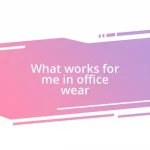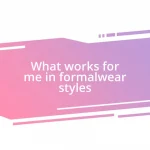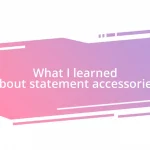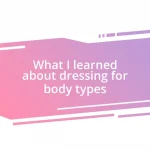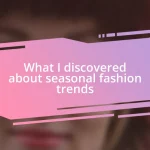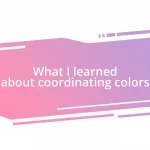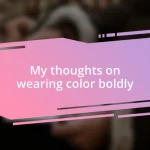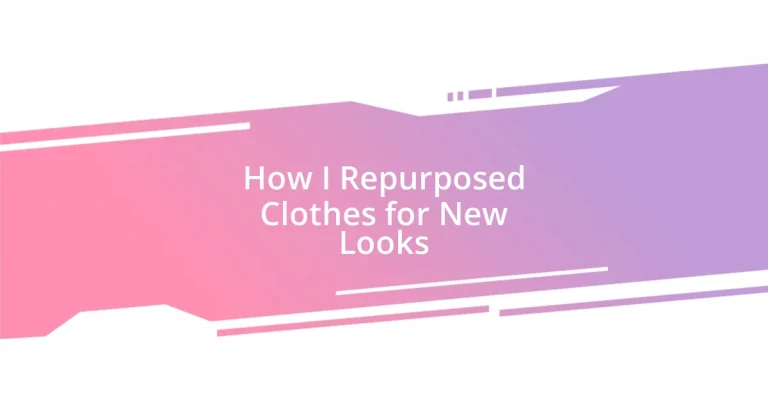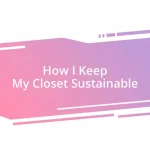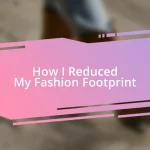Key takeaways:
- Repurposing clothing encourages creativity, personal expression, and sustainability, transforming garments into unique pieces with emotional significance.
- Essential tools for clothing transformation include fabric scissors, a sewing machine, fabric glue, and a measuring tape for accuracy and precision.
- Sustainable fashion practices such as clothing swaps, selecting eco-friendly materials, and repairing items can refresh your wardrobe and reduce waste.
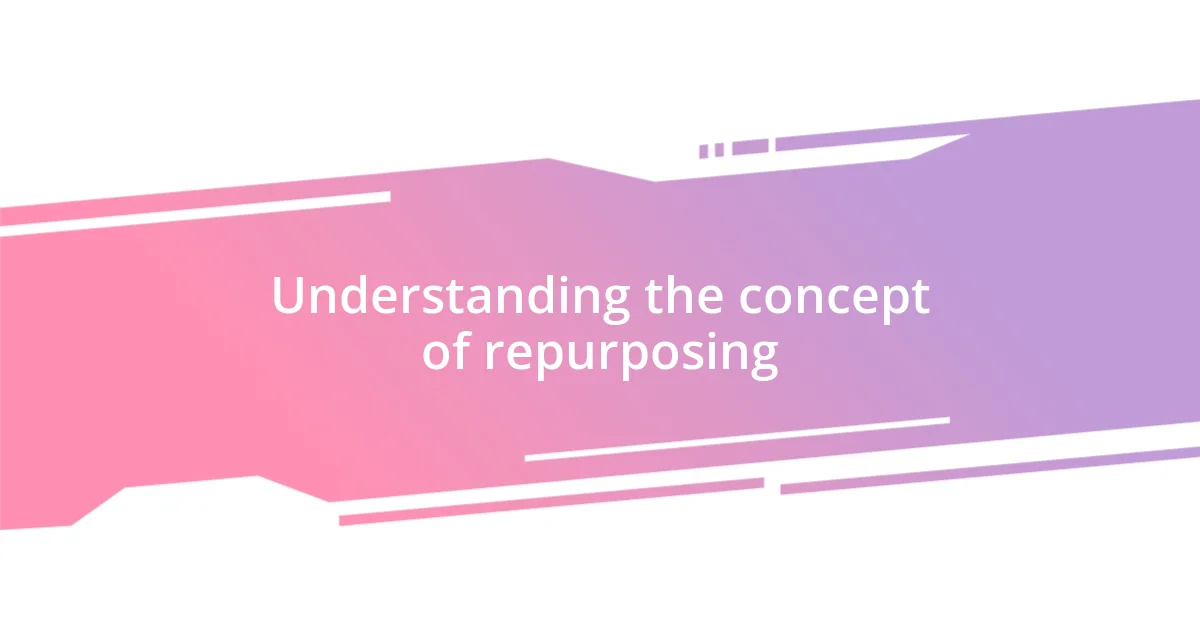
Understanding the concept of repurposing
Repurposing clothing goes beyond simply recycling; it’s about breathing new life into garments that may have lost their spark. I remember the thrill of transforming an old, oversized sweater into a chic off-the-shoulder top. It was an exhilarating moment when I realized that what once sat untouched in my closet could be a statement piece instead.
Have you ever looked at a piece of clothing and thought, “This could be something more”? That’s the essence of repurposing—it invites creativity and personal expression. For instance, I turned a pair of faded jeans into stylish denim shorts. Not only did this save money, but it also turned an unwearable item into my go-to summer staple.
It’s fascinating to think about how repurposing not only contributes to sustainability but also fosters a deep emotional connection to our wardrobe. Each piece carries a story, and when I look at my repurposed items, I feel proud of my resourcefulness. It’s like having a living scrapbook of memories that keeps evolving with my style.
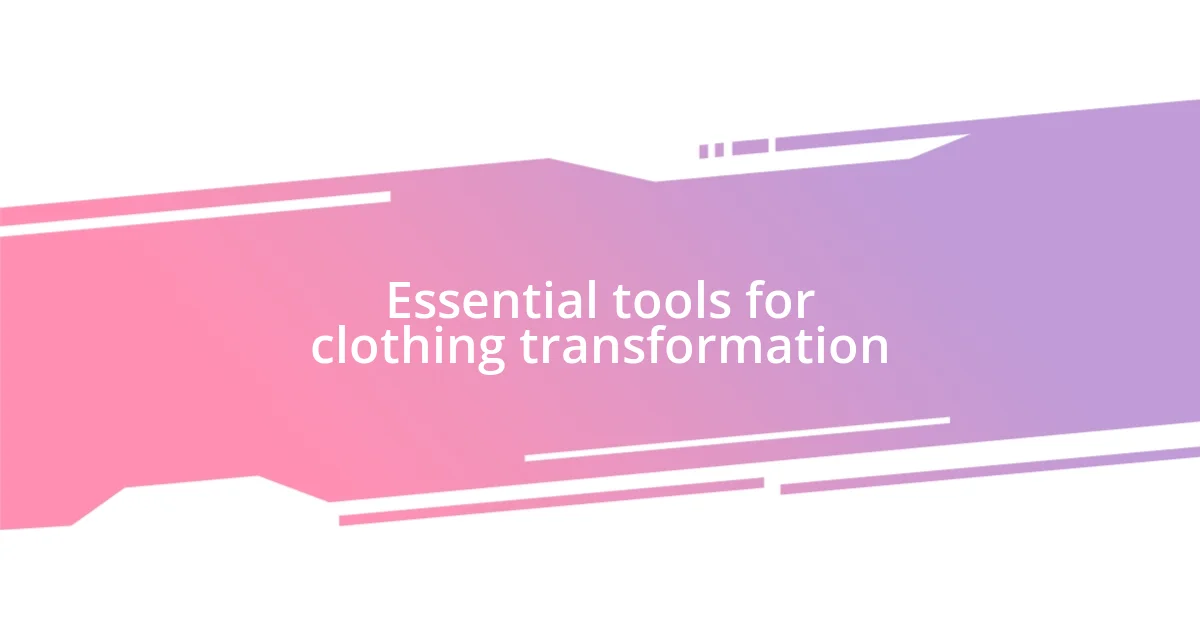
Essential tools for clothing transformation
When embarking on a clothing transformation journey, having the right tools can make all the difference. I’ve found that a solid pair of fabric scissors is essential; they allow for precise cuts without fraying the edges. I remember a time when I tried using regular scissors—what a mess! The fabric didn’t cut smoothly, and it resulted in a project that barely resembled my vision. Trust me, investing in good quality scissors is worth it.
Additionally, a sewing machine can be a game changer for more complex alterations. I recall the first time I used a sewing machine to hem an old maxi dress. It felt empowering to alter something that seemed fixed. Suddenly, I was able to make adjustments I never thought possible. And let’s not forget about fabric glue for those quick fixes or no-sew options. It’s perfect for applying patches or creating a fun layered look without getting tangled in thread.
Lastly, a measuring tape is invaluable in ensuring that all your transformations fit just right. I can’t tell you how many times I’ve eyeballed measurements only to be left with awkwardly fitting garments. There’s a satisfaction that comes with precision, and it truly elevates the final result of your transformation.
| Tool | Purpose |
|---|---|
| Fabric Scissors | Clean, precise cuts on fabric |
| Sewing Machine | Allows for sewing, hemming, and more complex alterations |
| Fabric Glue | Quick fixes and no-sew options |
| Measuring Tape | Ensures accurate measurements for fitting |
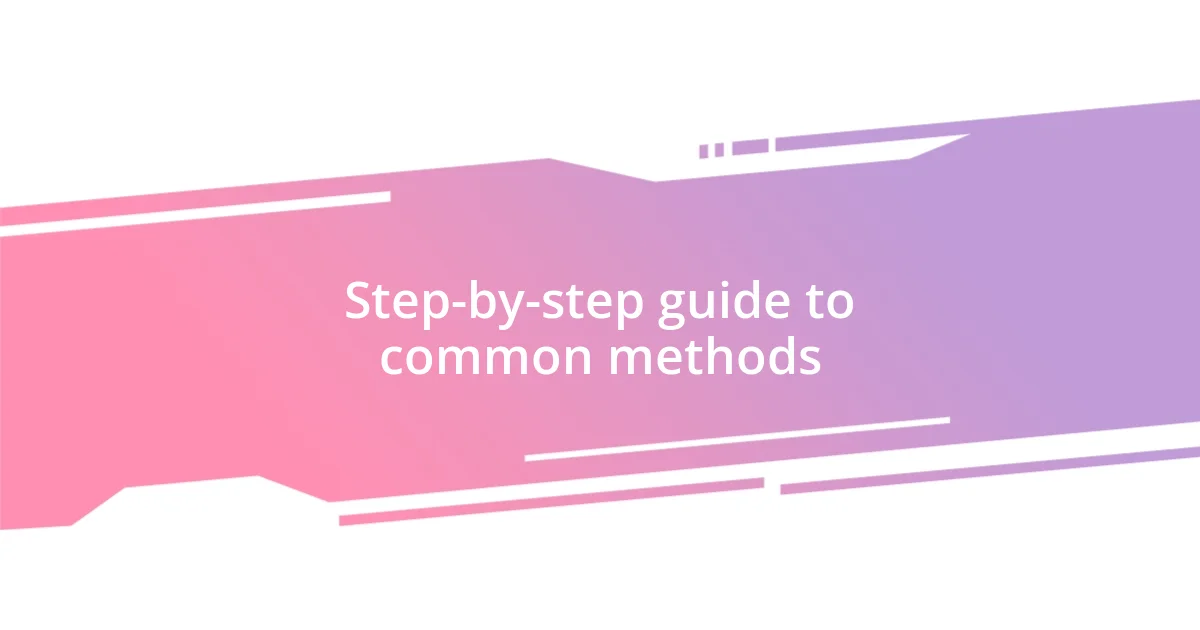
Step-by-step guide to common methods
When it comes to repurposing clothes, I’ve discovered that creativity often follows a few simple methods. One of my favorites is cutting and re-styling pieces. I had an old button-up shirt that I transformed into a trendy crop top. I cut off the sleeves, added a little ruching on the sides, and suddenly, it became the perfect addition to my summer wardrobe. The thrill of seeing a former staple take on a new life is honestly one of my favorite feelings.
Here’s a quick step-by-step for this method:
- Choose your item: Pick something you haven’t worn in a while, like an oversized shirt.
- Prepare your tools: Gather your fabric scissors and measuring tape.
- Cut strategically: Decide where to cut to create a crop look, ensuring you leave enough fabric to hem the edges if needed.
- Add details: Consider adding embellishments like laces or beads for a personalized touch.
- Try it on: Adjust the fit and style until it feels right for you.
Another common method that has served me well involves sewing—especially when it comes to modifying jeans. I once had a pair of jeans that were just a bit too long. Instead of letting them gather dust, I decided to turn them into a distressed pair of trendy cut-offs. I took my scissors and a bit of sandpaper to create that effortlessly worn vibe. Every time I wear those shorts, I can’t help but smile at the transformation journey they took with me.
Here’s how I approached the jean transformation:
- Assess the garment: Identify what alterations you want to make—length, fit, or style.
- Gather your tools: Have scissors, sandpaper (for distressing), and your sewing machine ready.
- Measure twice, cut once: Mark where you want to cut, ensuring it’s even on both sides.
- Distress the fabric: Use sandpaper to fray the edges and add character, if desired.
- Finish it off: Hem the edges if necessary to prevent fraying.
Each transformation not only refreshes my closet but also fills me with a sense of pride and accomplishment. It’s these small, creative victories that keep me inspired to keep turning the old into something wonderfully new.
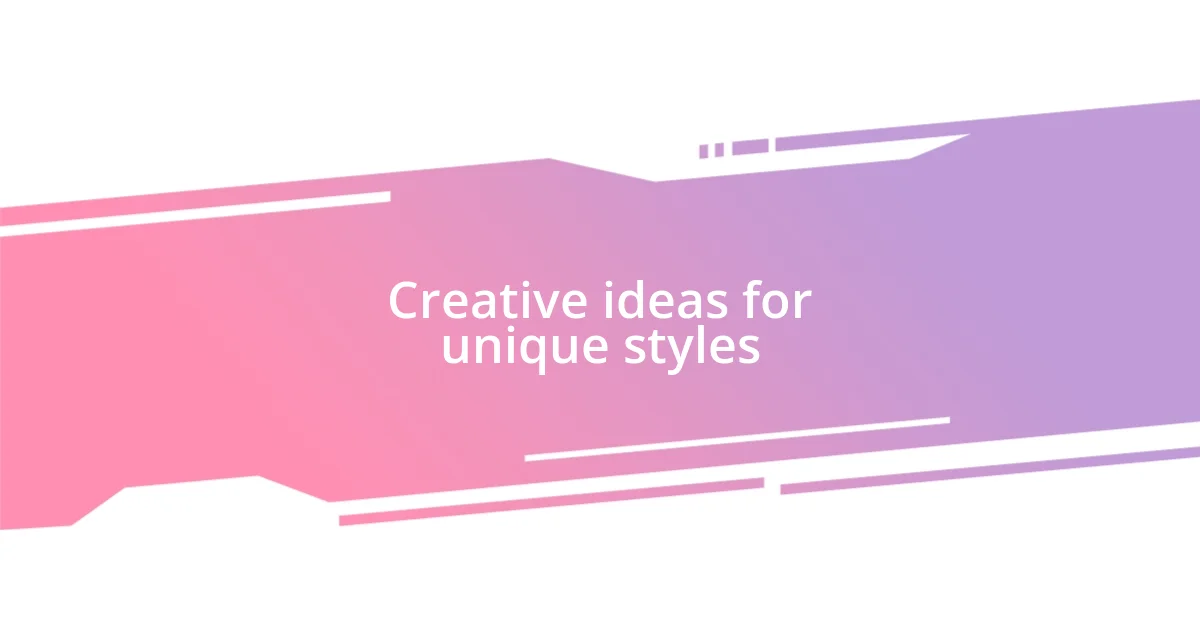
Creative ideas for unique styles
When I think about unique styles, one playful idea that comes to mind is the scarf transformation. I had this lovely silk scarf that I never wore because I wasn’t sure how to style it. In a moment of inspiration, I turned it into a chic halter top. I simply tied the ends behind my back and adjusted it for fit. It felt like wearing a piece of art! Have you ever thought about how versatile scarves can be? Experimenting with different knots and ties can make a huge difference in your wardrobe.
Layering is another fantastic strategy I love to use. I once layered a long-sleeve turtleneck under a sleeveless dress to create a whole new outfit. The combination not only added warmth but also an unexpected visual interest. Sometimes, a simple tweak, like adding a belt or a chunky cardigan, can elevate your look dramatically. Don’t you love how just a few adjustments can completely change the vibe of an outfit? It’s like discovering hidden potential in your wardrobe.
Lastly, I find that adding vintage or thrifted accessories can dramatically shift a style. A brooch I picked up at a yard sale transformed a plain blazer into something unique and eye-catching. It sparked conversations everywhere I went, and I felt proud of my creative touch. Have you ever considered the power of accessories? They can breathe new life into well-loved garments, making them not only fashionable but also deeply personal. The joy of transforming your wardrobe into something that expresses who you are is genuinely rewarding!
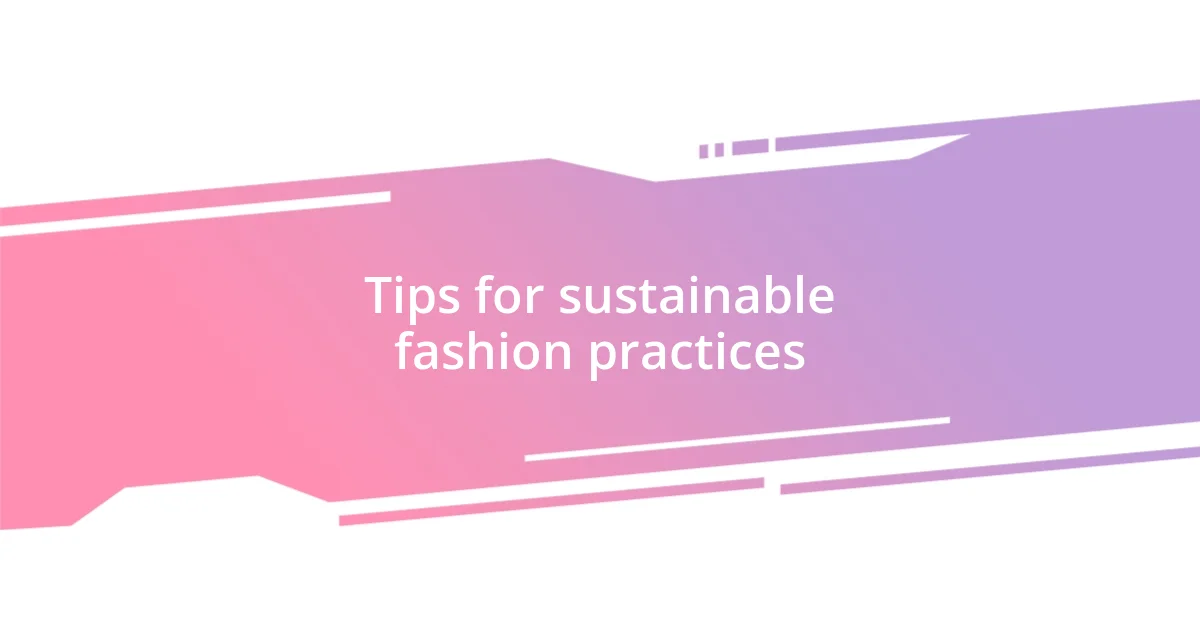
Tips for sustainable fashion practices
Sustainable fashion practices are all about making mindful choices that extend the life of your wardrobe. One tip I swear by is swapping clothes with friends. I remember hosting a small gathering where we all brought items we no longer wore. It was like a mini fashion show as we tried on each other’s pieces, and I ended up with a stunning jacket I never would have bought on my own. It’s a fun way to refresh your closet without spending a dime and reduces waste—who wouldn’t want that?
Another practice I’ve embraced is carefully selecting fabrics before buying. When I shop, I pay close attention to materials like organic cotton or Tencel, which are more environmentally friendly. I’ll never forget discovering a thrift store’s wool sweaters during one of my treasure hunts. Knowing that I’m supporting eco-friendly practices makes me feel good about my wardrobe choices. Plus, it often leads to unique finds that stand out in a crowd. Have you ever thought about how the right fabric can enhance not just your look, but also your eco-footprint?
Lastly, repairing clothing instead of tossing it out has been a game-changer for me. I had a pair of beloved boots that developed a small tear. Instead of heading out to buy new ones, I grabbed a needle and thread. It wasn’t perfect, but the charm of DIY repairs gave them a fresh character. Every time I put them on, I feel a connection to the effort I invested—don’t you find it rewarding to wear something that tells a story? Sustainable fashion isn’t just about the clothes; it’s about the memories and the creativity we weave into our wardrobes.
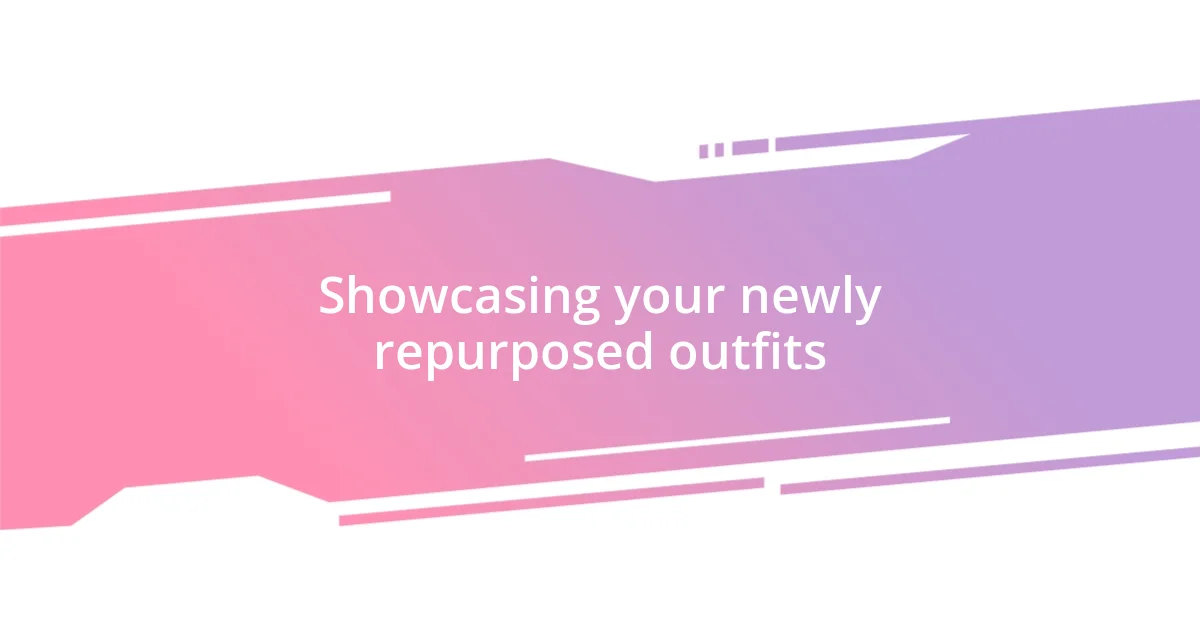
Showcasing your newly repurposed outfits
Showcasing your newly repurposed outfits can be an exciting way to express your creative flair. I recently wore a denim jacket that I adorned with patches I handpicked from various thrift stores. Each patch tells a story of its own, giving my outfit a personalized touch. Who would have thought a simple jacket could make me feel so unique and original?
Sharing your new looks on social media is also a fantastic way to inspire others. I remember posting pictures of an old sundress I turned into a chic midi skirt, complete with a matching belt I created from leftover fabric. The feedback was wonderful, and I loved hearing how others were motivated to try similar transformations. Have you considered how social platforms can be a canvas for showcasing your creativity?
I’ve even hosted a mini photoshoot with friends wearing our repurposed outfits. It was more than just taking pictures; it became a memory-making event. Laughter, compliments, and reminiscing about our transformations made the day truly special. Seeing how each of us styled our pieces differently was a reminder that fashion is deeply personal and expressive. Isn’t it fascinating how the same garment can be reimagined in countless ways, reflecting diverse perspectives?
